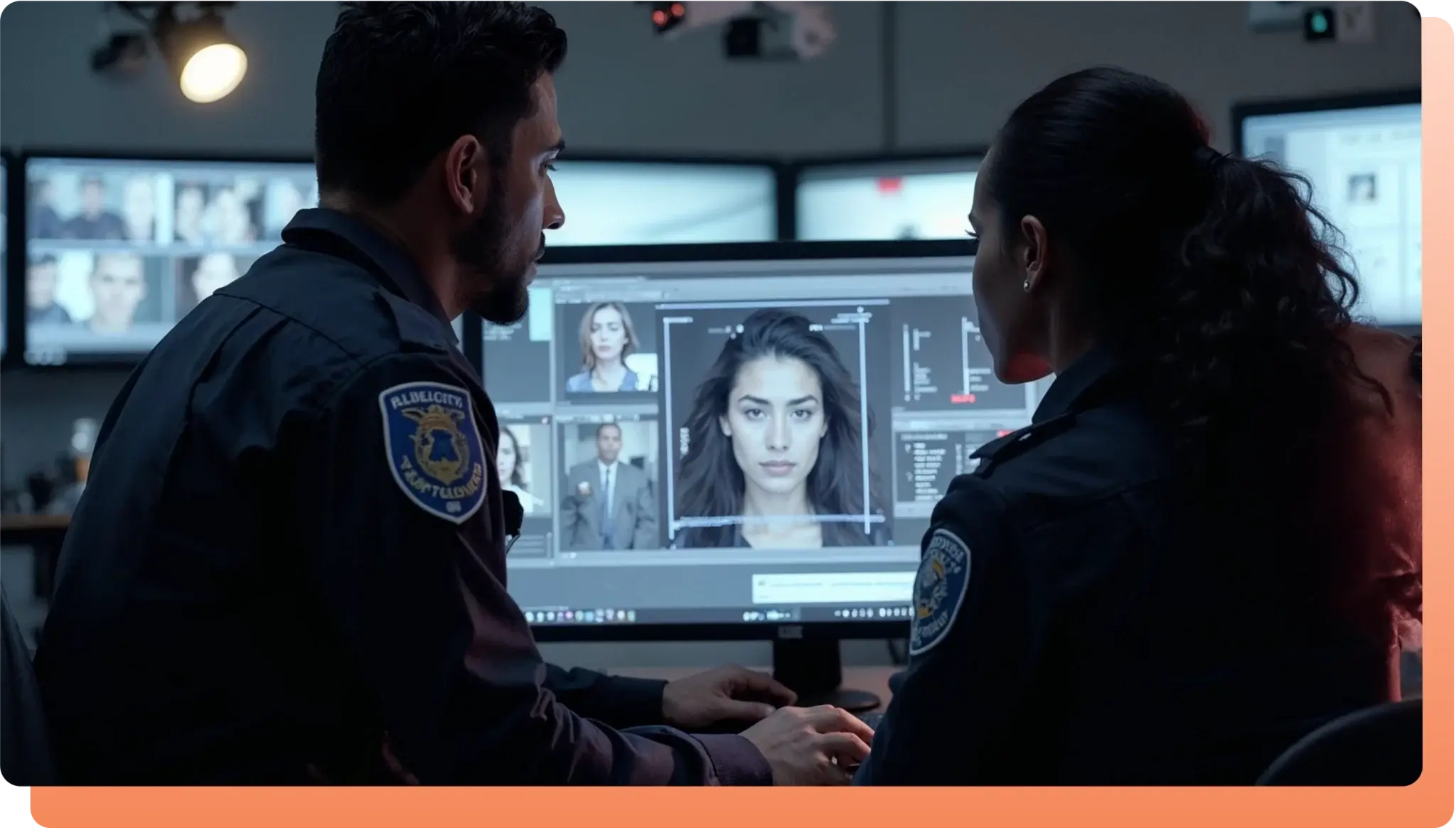As law enforcement agencies embrace technology, the surge in digital evidence from body cameras, surveillance systems, and mobile devices presents significant challenges in managing, storing, and securing data. With growing volumes of sensitive information, agencies must balance transparency and justice with privacy protections and compliance with strict data laws
How Facial Recognition is Transforming Digital Evidence Management
By Malaika Batool on Nov 20, 2024 8:19:45 AM

Discover how facial recognition in digital evidence management automates redaction, enhances privacy, ensures compliance, and reduces operational strain for law enforcement.
Imagine combing through endless hours of footage, manually redacting faces to protect the privacy of bystanders, and trying to spot crucial evidence, all while your caseload keeps piling up. For law enforcement agencies, time, accuracy, and privacy aren’t just important rather they’re essential. But with the flood of digital evidence from body cameras, security feeds, and public surveillance, how much strain is this placing on your team?
The demands are escalating, yet so are the challenges, especially as law enforcement is now under public scrutiny to manage digital evidence ethically and securely. When speed and compliance with privacy laws are mission-critical, can your current processes keep up?
Managing the Complexities of Digital Evidence
The Overwhelming Volume of Digital Evidence in Modern Policing
The explosion of digital evidence in law enforcement is undeniable. From body camera footage and dashcam videos to footage obtained from businesses or public venues, the data intake for law enforcement has surged. Body-worn cameras alone, mandated by many agencies for accountability, generate hours of footage daily. For example, the Chula Vista, California, police department, with 200 officers using body cameras, generates approximately 33 TB of data annually, equivalent to 17 million photographs. While this data is vital for transparency, fairness, and justice, the volume can bog down resources and complicate workflows, from storage costs to the manual review process.
Moreover, Digital evidence often includes bystanders, suspects, and victims with all identifiable information that law enforcement agencies are ligated to protect. The challenge is that each video is saturated with personally identifiable information (PII) that can put individuals' privacy at risk. In the context of legal frameworks like the GDPR, CCPA, and other privacy regulations, mishandling this data can lead to severe penalties and reputational damage, pushing agencies to prioritize compliance without adding further strain on resources.
Manual Redaction: A Time-Intensive and Costly Process
The redaction of sensitive information, such as bystanders' faces and personal details, is a crucial yet labor-intensive part of evidence processing. Many agencies still rely on manual methods, which involve blurring or pixelating each face individually. This time-consuming process strains limited resources and leaves little room for mistakes. Even one missed face or identifier can lead to serious privacy violations, risking legal consequences and damaging public trust. Inaccurate redaction not only compromises privacy but also erodes confidence in law enforcement's ability to handle sensitive information properly.
Privacy Laws and Compliance Pressures
Law enforcement agencies operate in an environment where privacy regulations are evolving quickly. Laws like the GDPR in Europe and the CCPA in California mandate strict guidelines for handling PII, particularly in cases of digital evidence. The stakes are high, as failure to comply can lead to hefty fines, legal consequences, and eroded trust with the public.
In addition, ongoing public scrutiny of law enforcement practices has made transparency and accountability central pillars of public safety work, making privacy-compliant digital evidence management a critical focus for any law enforcement agency. Just in 2023, the number of FOIA requests surpassed 1.1 million.
In today's climate, public trust hinges on transparency. A single privacy violation can lead to public outrage, eroding years of trust built within the community. Every misstep in data privacy whether from failing to redact bystander information or from mishandling sensitive evidence—undermines this relationship and impacts the perceived integrity of the department.
The Costs of Inefficient Digital Evidence Management
Inefficient digital evidence management and manual redaction create financial and operational burdens for law enforcement agencies, leading to backlogs, delays, and increased costs. These inefficiencies not only strain resources but also risk damaging public trust through privacy breaches and mishandling of sensitive data.
Operational and Financial Strain
Without a more streamlined, efficient approach to digital evidence management and redaction, law enforcement agencies face an unmanageable burden. Every hour spent on manual review and redaction is an hour not spent solving cases or ensuring public safety. The financial cost of relying on manual processes for data storage, retrieval, and redaction only compounds the issue, leading to ballooning operational expenses. For many departments, budget constraints are an ongoing concern, yet the demand for compliant, high-quality evidence handling remains critical.
The sheer volume of digital evidence results in unsustainable workloads for both officers and analysts, creating a bottleneck that delays critical cases. In high-volume departments, the backlog of footage awaiting review and redaction can become overwhelming, leaving cases stalled or unresolved. For example, the Oakland Police Department is facing immense backlogs due to the number of record requests from external parties, leading to struggles in meeting these demands.
The Public Trust Factor
In an age of high accountability, public trust is invaluable yet delicate. Every privacy breach, accidental disclosure of PII, or misstep in data handling could mean severe backlash, lawsuits, or public demonstrations. Without reliable redaction tools, agencies risk releasing footage with compromised privacy, eroding the trust that agencies work tirelessly to earn and maintain. Mistakes in digital evidence handling often have lasting consequences on community relationships.
Legal Risks and Non-Compliance Penalties
Failure to adhere to privacy laws like GDPR and CCPA doesn’t just result in financial fines, but it proves to be a legal liability. Mishandling PII in digital evidence can lead to substantial fines, reputational damage, and public backlash. Furthermore, compliance violations can invite scrutiny from regulatory bodies, impacting the operational efficiency and public image of the agency involved. Non-compliance isn’t simply a matter of financial penalties but can also mean ongoing legal battles, affecting every aspect of department operations and relations with the public.
Leveraging AI-Driven Facial Recognition for Digital Evidence Management
AI-powered facial recognition technology enhances digital evidence management by automating the identification and redaction processes, improving efficiency and accuracy. This reduces manual review time, ensures compliance with privacy regulations, and minimizes human error in handling sensitive data.
Efficiency Through AI-Powered Facial Recognition in Evidence Management
Implementing facial recognition technology within digital evidence management systems (DEMS) has introduced a new era of efficiency and reliability in law enforcement. Facial recognition offers quick, automated ways to sift through extensive footage, identifying suspects accurately while eliminating the need for tedious manual review. The value of AI lies not only in its speed but also in its accuracy, which dramatically reduces the likelihood of human error in evidence review and redaction.
- Automated Identification: AI-powered facial recognition identifies individuals within footage quickly and with high accuracy. This capability drastically reduces the time spent reviewing footage, allowing investigators to focus more on case building and analysis rather than routine tasks.
- Faster, Accurate Redaction: Automated redaction, enabled by facial recognition, removes the need for manually blurring faces or identifying PII. The system recognizes faces within seconds, ensuring compliance with privacy regulations, especially when video footage is subject to public release.
- Enhanced Compliance with Privacy Regulations: Facial recognition technology not only speeds up the redaction process but also ensures that redaction is thorough, protecting bystander privacy and adhering to data protection laws like GDPR, which are especially strict about PII handling.
Reducing the Operational Burden with AI
The automation offered by facial recognition technology in DEMS means significant resource savings for law enforcement agencies. By automating repetitive tasks, law enforcement teams can redirect time and resources to more critical and strategic activities, such as active investigations, analysis, and community outreach. This efficiency supports a sustainable approach to resource management while reducing operational costs associated with manual data handling.
- Time Savings: Automated redaction processes save hours or even days of work, depending on the volume of footage processed. Video evidence that once required extensive manual review can now be processed within minutes with bulk redaction, leading to faster case resolutions and more agile investigative operations.
- Improved Accuracy: By minimizing human intervention in repetitive tasks, AI and facial recognition reduce the risk of error, ensuring that redacted footage complies with privacy regulations without compromising case integrity. This improved accuracy is essential in maintaining privacy, protecting evidence integrity, and avoiding costly compliance issues.
- Optimal Resource Allocation: The resources saved from adopting facial recognition in DEMS can be redirected to other essential areas within the department, such as training, community relations, or cybersecurity measures, further enhancing departmental efficiency.
Practical Applications in Law Enforcement
Facial recognition technology is particularly useful in managing high-volume evidence situations, such as protests or large gatherings. In such scenarios, law enforcement often needs to identify persons of interest without infringing on the privacy rights of innocent bystanders. With facial recognition-enabled DEMS, agencies can scan hours of footage for specific individuals, isolating suspects or persons of interest quickly while ensuring that bystander privacy remains intact through automated redaction.
Secondly, in the courtroom, the reliability of evidence is paramount. The digital evidence presented must be compliant, unaltered, and free from privacy violations. Facial recognition in DEMS ensures that footage is accurately redacted for PII, providing legal professionals and juries with trustworthy evidence. For both defense and prosecution, this capability strengthens case reliability and upholds privacy protections, minimizing legal challenges related to improper evidence handling.
Implementation Tips for Facial Recognition in Digital Evidence Management Systems
- Assess Compatibility with Existing Systems: Before implementation, evaluate whether your current DEMS can integrate with facial recognition tools. Ensuring compatibility streamlines workflows and avoids integration issues, making adoption smoother.
- Prioritize Data Security and Access Control: As with any sensitive data, secure storage and access control are essential. Ensure that facial recognition-enabled DEMS aligns with best practices in cybersecurity to protect sensitive information and prevent unauthorized access.
- Focus on Compliance Training and Monitoring: Once implemented, conduct regular training for personnel on privacy compliance and best practices for using facial recognition technology. Continuous monitoring will help address any potential compliance issues early, ensuring the system remains effective and law-abiding.
Key Takeaways
-
Automation of Redaction with Facial Recognition
Facial recognition technology automates the redaction of sensitive information, such as faces, in digital evidence. This significantly reduces the time and effort spent on manual redaction, enhancing both efficiency and accuracy in handling digital evidence. -
Enhanced Compliance with Privacy Laws
By automatically identifying and redacting faces and personally identifiable information (PII), facial recognition helps law enforcement agencies comply with strict data privacy regulations like GDPR and CCPA, preventing costly fines and legal challenges. -
Faster Processing of Evidence
Automated redaction powered by facial recognition allows law enforcement agencies to process large volumes of video footage much faster than manual methods. This improves response times and helps avoid backlogs, ensuring timely case resolution. -
Increased Accuracy and Reduced Human Error
Facial recognition minimizes human intervention, reducing the risk of errors in redaction. This ensures that the privacy of individuals is consistently protected, and evidence integrity is maintained, which is critical for both legal proceedings and public trust. -
Operational Efficiency and Cost Savings
By saving time on manual redaction, law enforcement agencies can allocate resources more effectively to other critical areas, such as investigations, officer training, or community outreach. This leads to a more efficient use of available resources and reduces operational costs. -
Streamlined Integration into Existing Evidence Systems
Facial recognition technology can seamlessly integrate with existing Digital Evidence Management Systems (DEMS), enhancing workflows without disrupting current practices. This ensures smooth implementation and maximizes the value of existing infrastructure. -
Transparency and Accountability
Automated processes such as facial recognition create a transparent audit trail, ensuring that all redactions and evidence handling actions are tracked. This improves accountability and supports the integrity of investigations, making it easier to defend evidence handling in legal settings. -
Facilitates Identification in High-Volume Cases
Facial recognition is especially valuable in large-scale cases, such as protests or public events, where law enforcement needs to identify suspects quickly while protecting the privacy of innocent bystanders. This capability helps law enforcement focus on suspects while ensuring compliance with privacy laws. -
Strengthens Evidence in the Courtroom
By ensuring that video evidence is properly redacted and complies with privacy laws, facial recognition technology strengthens the reliability of evidence in court, which is essential for both prosecution and defense teams. This helps maintain the integrity of legal proceedings. -
Public Trust and Transparency
Facial recognition enhances public trust by ensuring privacy compliance and accuracy in evidence handling. With more efficient processes in place, law enforcement can demonstrate their commitment to transparency, accountability, and ethical practices, which builds community trust.
A New Era in Evidence Management
Facial recognition in digital evidence management is transforming how law enforcement agencies handle digital evidence. Beyond reducing the administrative burden, it enables a seamless, compliant approach to privacy while enhancing evidence reliability. In adopting AI-powered facial recognition, law enforcement can streamline evidence workflows, achieve compliance with data privacy regulations, and, ultimately, refocus on serving communities with integrity and transparency.
People Also Ask
How does facial recognition improve digital evidence management?
Facial recognition automates the identification and redaction processes, saving time and enhancing accuracy in handling sensitive evidence.
Is automated redaction compliant with privacy laws?
Yes, automated redaction tools are designed with privacy regulations in mind, minimizing exposure of PII and ensuring adherence to GDPR and other laws.
What are the risks of manual redaction?
Manual redaction is labor-intensive, prone to human error, and increases the risk of privacy breaches, potentially leading to legal issues.
Is facial recognition technology secure for sensitive evidence?
Yes, modern facial recognition technology includes security measures such as encryption and access control, safeguarding sensitive information.
How much time can automate redaction save in larger departments?
Automated redaction can save significant time, processing in minutes what would take hours or even days with manual review, ideal for high-volume evidence handling.
How does facial recognition contribute to public trust?
By automating privacy protections and ensuring accurate evidence handling, facial recognition supports transparency and builds public trust.
Jump to
You May Also Like
These Related Stories

Enhancing Digital Evidence Security with AI-Based PII Redaction

How to Ensure Privacy and Security When Sharing Digital Evidence





No Comments Yet
Let us know what you think